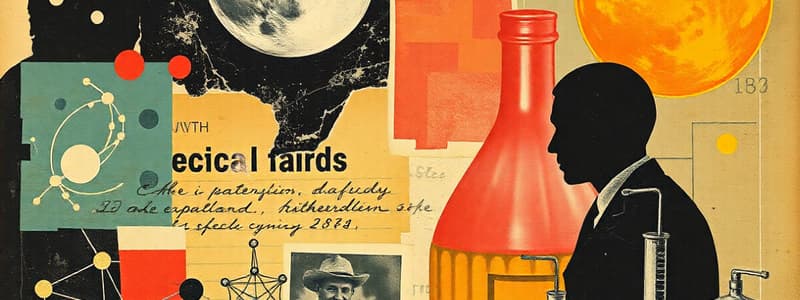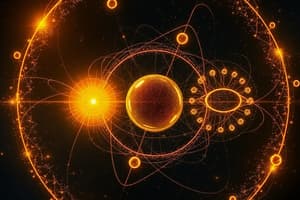Podcast
Questions and Answers
Which statement best describes isotopes?
Which statement best describes isotopes?
- Atoms with the same number of protons and different numbers of neutrons. (correct)
- Atoms with an equal number of protons and neutrons.
- Atoms that have lost electrons to become charged particles.
- Atoms with the same number of neutrons and different numbers of protons.
Alpha radiation can travel long distances in air.
Alpha radiation can travel long distances in air.
False (B)
What does the term 'half-life' refer to in the context of radioactive substances?
What does the term 'half-life' refer to in the context of radioactive substances?
The time it takes for half of the radioactive nuclei to decay.
The nuclear model of the atom replaced the __________ model due to the results of Rutherford's experiment.
The nuclear model of the atom replaced the __________ model due to the results of Rutherford's experiment.
Which type of radiation is emitted as an electron?
Which type of radiation is emitted as an electron?
Match the type of radiation with its characteristic:
Match the type of radiation with its characteristic:
Ions are formed when an atom gains or loses neutrons.
Ions are formed when an atom gains or loses neutrons.
The __________ is the rate at which a radioactive source decays, measured in becquerels (Bq).
The __________ is the rate at which a radioactive source decays, measured in becquerels (Bq).
Flashcards
What are isotopes?
What are isotopes?
Atoms of the same element that have the same number of protons but different numbers of neutrons.
What is an ion?
What is an ion?
An atom that has gained or lost electrons, resulting in a net electrical charge.
What is radiation?
What is radiation?
The emission of energy from an unstable atom's nucleus, often in the form of particles or electromagnetic waves.
What is half-life?
What is half-life?
Signup and view all the flashcards
Describe alpha radiation.
Describe alpha radiation.
Signup and view all the flashcards
Describe beta radiation.
Describe beta radiation.
Signup and view all the flashcards
Describe gamma radiation.
Describe gamma radiation.
Signup and view all the flashcards
What is contamination?
What is contamination?
Signup and view all the flashcards
What is the nucleus?
What is the nucleus?
Signup and view all the flashcards
What are ions?
What are ions?
Signup and view all the flashcards
What is activity?
What is activity?
Signup and view all the flashcards
Study Notes
History of the Atom
- The plum pudding model described an atom as a sphere of positive charge with negatively charged particles (electrons) dispersed throughout.
- The modern atomic model depicts a nucleus at the atom's center, containing protons and neutrons, and most of the atom's mass. Electrons orbit the nucleus at different energy levels.
Rutherford's Alpha Scattering Experiment
- Alpha particles were directed at a thin gold foil.
- Most alpha particles passed straight through the foil.
- Some particles were deflected at small angles.
- A small fraction of alpha particles were deflected back towards the source.
- This experiment disproved the plum pudding model.
- The results indicated the atom is primarily empty space with a small, dense, positively charged nucleus.
Isotopes
- Isotopes are varieties of the same element having the same number of protons but differing numbers of neutrons.
- The varying number of neutrons alters the mass number of the isotope.
- The charge remains the same because neutrons have no charge.
Ions
- Ions are atoms lacking a balance of protons and electrons, having different numbers of negatively charged electrons.
- The number of protons remains consistent with the neutral atom, determining the atomic number and the element.
- The differing number of electrons changes the overall charge of the ion.
- The mass of an atom remains largely unchanged due to the negligible mass of electrons.
Radiation
- Alpha radiation is released from the nucleus when an alpha particle (consisting of two protons and two neutrons) is emitted.
- Alpha radiation is highly ionizing, travels a short distance in air (a few centimeters), and is stopped by a sheet of paper. Alpha radiation is used in smoke detectors.
- Beta radiation is emitted from the nucleus when a high-speed electron (beta particle) is released.
- Beta radiation is moderately ionizing, travels further in air (a few meters), and is stopped by aluminum. Beta radiation is utilized in material thickness gauges.
- Gamma radiation involves the emission of electromagnetic waves (gamma rays) from the nucleus, and are not particles.
- Gamma radiation is weakly ionizing, travels long distances in air (up to several kilometers), and is absorbed by lead or thick concrete. Gamma radiation is used for sterilization of medical equipment.
Alpha Radiation
- It is highly ionizing, leading to significant cellular damage.
- Its range in air is relatively short (a few centimeters), easily stopped by paper.
- Alpha radiation is used in smoke detectors.
Beta Radiation
- It is moderately ionizing.
- Beta particles travel further in air (a few meters) and are stopped by aluminum.
- Beta radiation is used in material thickness gauges.
Gamma Radiation
- It is weakly ionizing.
- Gamma rays have a very long range in air (up to several kilometers) and are absorbed primarily by lead or thick concrete.
- Gamma radiation is used in sterilizing medical equipment.
Half-Life
- Half-life is the time required for half of the radioactive nuclei in a sample to decay.
- Radioactive decay is a random process.
- Activity refers to the rate of radioactive decay and is measured in Becquerels (Bq).
Radiation Risks
- Irradiation is exposure to radiation.
- Irradiation is minimized by keeping radioactive sources in lead-lined containers.
- Beta and gamma radiation present greater irradiation risks due to their ability to penetrate skin.
- Contamination involves radioactive particles on objects or surfaces.
- Contamination prevention includes personal protective equipment (PPE) like gloves or protective suits.
- Alpha radiation presents a greater contamination risk due to its high ionizing potential.
Studying That Suits You
Use AI to generate personalized quizzes and flashcards to suit your learning preferences.




